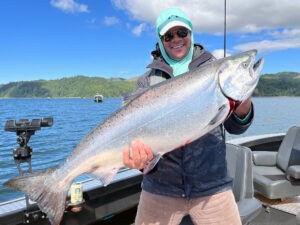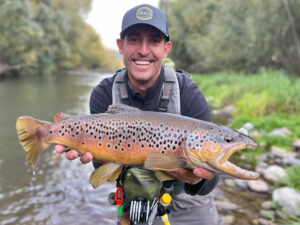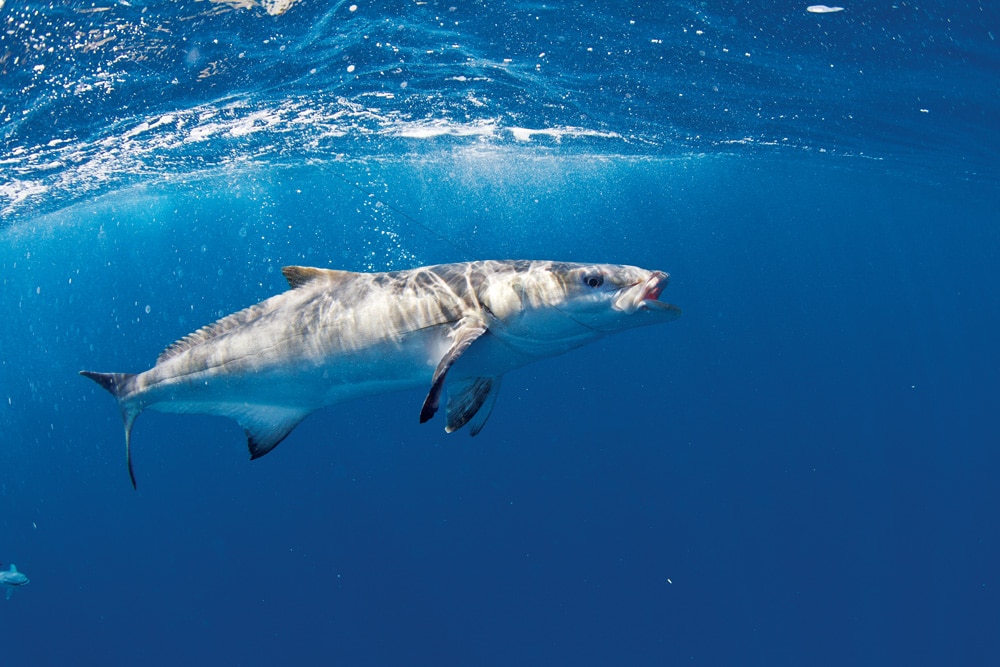
Cobia: Coastal Nomad
“No, that’s not a shark. Not a remora either. Yes, definitely cast your bait; it’s a cobia!”
I’m sure many charter skippers and guides from the mid-Atlantic through the Gulf have issued such instructions more than once. Cobia might be hard to identify and easily confused with sharks, especially if they’ve appeared suddenly from the green periphery, but their arrival energizes anglers in a heartbeat. They are one of the best-tasting, most nondescript fishes that swim in all tropical and subtropical waters (sans the eastern Pacific). Whether you fish off Australia, Japan, India or the Southeast United States, the cobia you catch are the same species —Rachycentron canadum— the sole member of its family.
So whether you call them crab-eaters, lemonfish, ling, cobia or something else entirely, there’s plenty to the brown bomber that swims curiously up to your boat. Once hooked, a cobia fights as hard as a bull bucking a cowboy. The life history of coastal pelagic cobia might not be as studied as some other game fish, but what is known might surprise you — and catch you more fish.
The Biology of Cobia
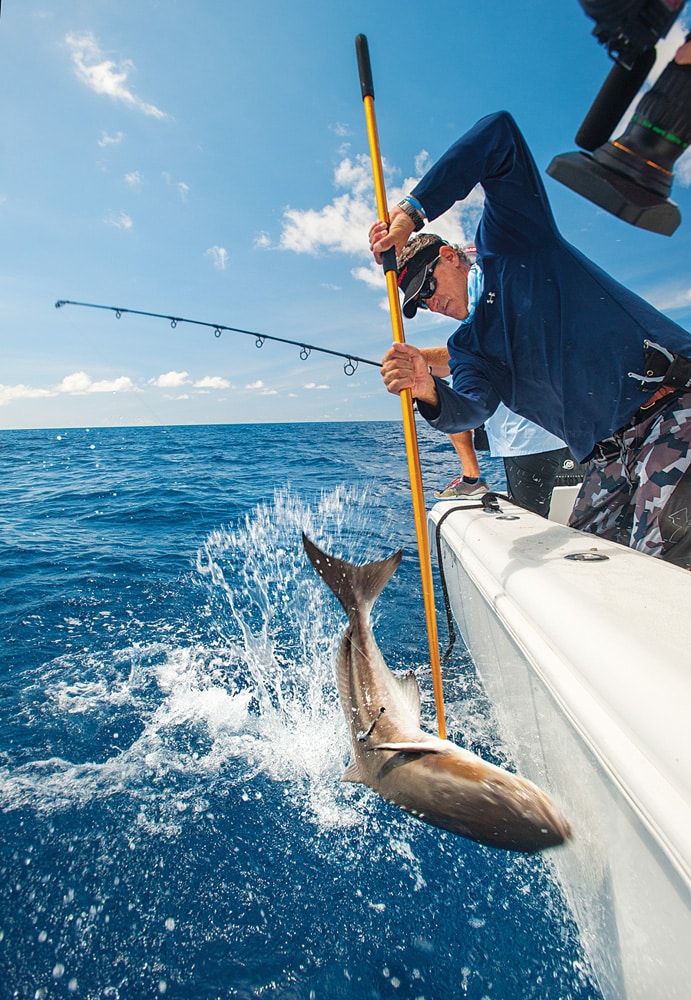
Cobia are rapid growers and fairly quick to mature, according to researcher Nancy Brown-Peterson, at the University of Southern Mississippi’s Department of Coastal Studies.
“Cobia have a long reproductive season — April through September — in the United States, and an individual female is capable of spawning as many as 36 times during a season,” Brown-Peterson says. “They spawn in the coastal waters of the continental shelf, not in bays, estuaries or right along the shoreline. Currently there is little evidence of the actual spawning-aggregation activity.”
Female cobia, which grow faster and bigger than males, produce small, pelagic eggs that drift along the continental shelf; researchers have captured the larvae offshore in surface waters of the Gulf of Mexico from May through September.
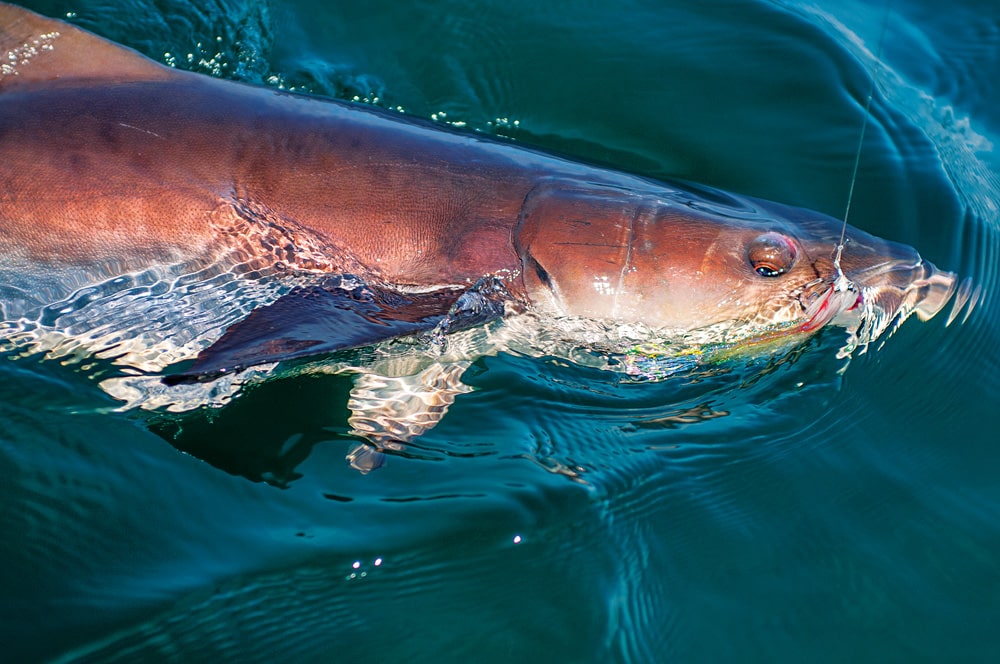
“Due to their small size and relatively weak swimming ability,” she says, “they are likely dependent on current and winds for movement in the first several weeks of life. We really don’t have much information about their early life history.”
What is known is that cobia grow tremendously in their first year, though not as quickly as bluefin tuna or mahimahi. Cobia in grow-out pens in warm, Puerto Rican waters grew 13.2 pounds in about a year. Cobia stocked in higher-density pens in slightly cooler waters of the Bahamas still grew 7.7 pounds in 346 days. Pelagic species such as dolphin, wahoo, and cobia tend to grow quickly, and have relatively short lives; conversely, benthic species like snapper and grouper can live for decades, growing much more slowly.
Stringent size regulations in the Gulf of Mexico fishery (33-inch fork length minimum) ensure that cobia have matured before anglers can keep them for dinner — rightfully — but that does limit the data scientists have on their age and size at maturity.
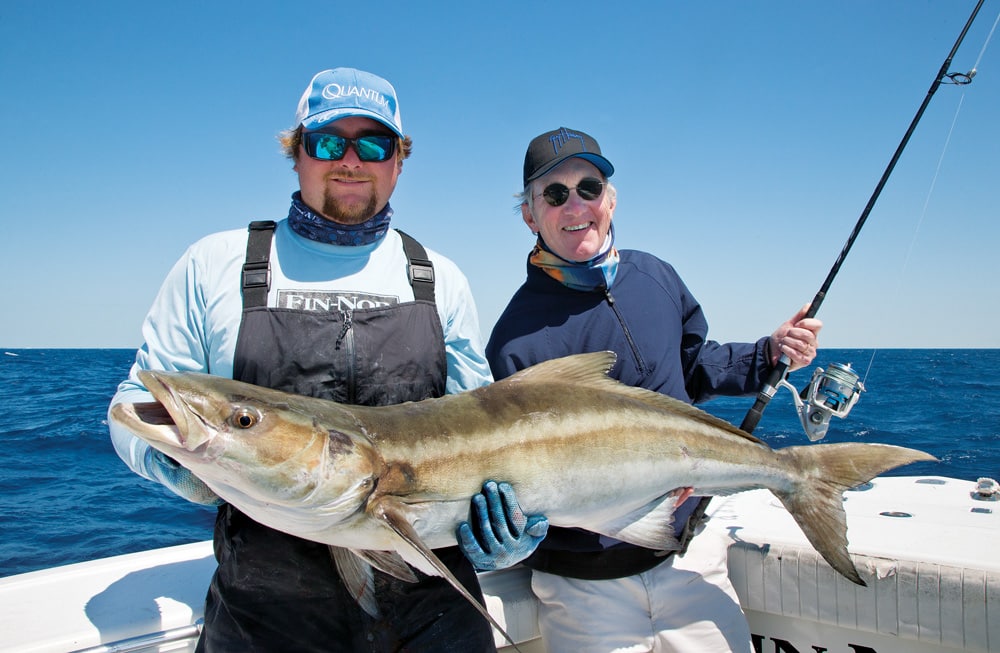
“The smallest reproductively active female we encountered was 27.5 inches, which corresponds to a one- or two-year-old fish,” says Brown-Peterson. “The smallest active male we found was 25 inches, a one-year-old fish. However, both males and females may mature at smaller sizes — we just don’t have samples of smaller fish — and size at maturity may vary within geographic region.”
Growth rates and maturation likely vary with region. Cobia were observed engaging in courtship behavior and began spawning naturally after 10 months in the stocked pens off Puerto Rico, says Daniel Benetti, a University of Miami aquaculture professor who assisted in the experimental cobia cages.
Tagging Cobia for Science
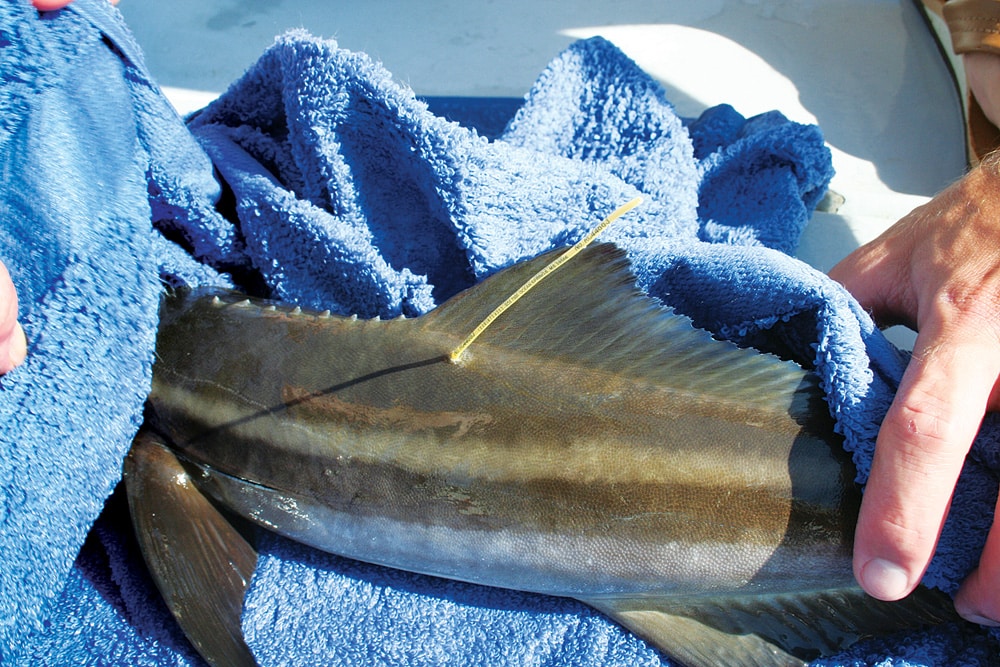
One definitive way to track the movements of a species is via a dedicated tagging program. Tracking cobia allows regulators to manage the species (and can also help anglers know when and where to find cobia off their coastline). Satellite tags have already revealed that ling almost never dive deep, choosing to stay in the water column above 200 feet deep.
The Sport Fish Tag and Release Program, at the University of Southern Mississippi’s Gulf Coast Research Laboratory, utilizes angler participation to tag cobia throughout the Gulf of Mexico and in the Atlantic. The program can trace its beginnings way back to 1988 in Biloxi, Mississippi. Since then, thousands of anglers have tagged cobia, with about a 6.4 percent recapture rate.
Read Hendon, director for the Center for Fisheries Research & Development, and Jim Franks, senior research scientist at the Center for Fisheries Research & Development, head the program.
“The bulk of our tags is sent out to northern Gulf and Florida Panhandle anglers,” says Hendon. “We send free tagging kits that include 10 4½-inch yellow Hallprint (‘spaghetti’) tags and data card. The field effort is completely up to the anglers.”
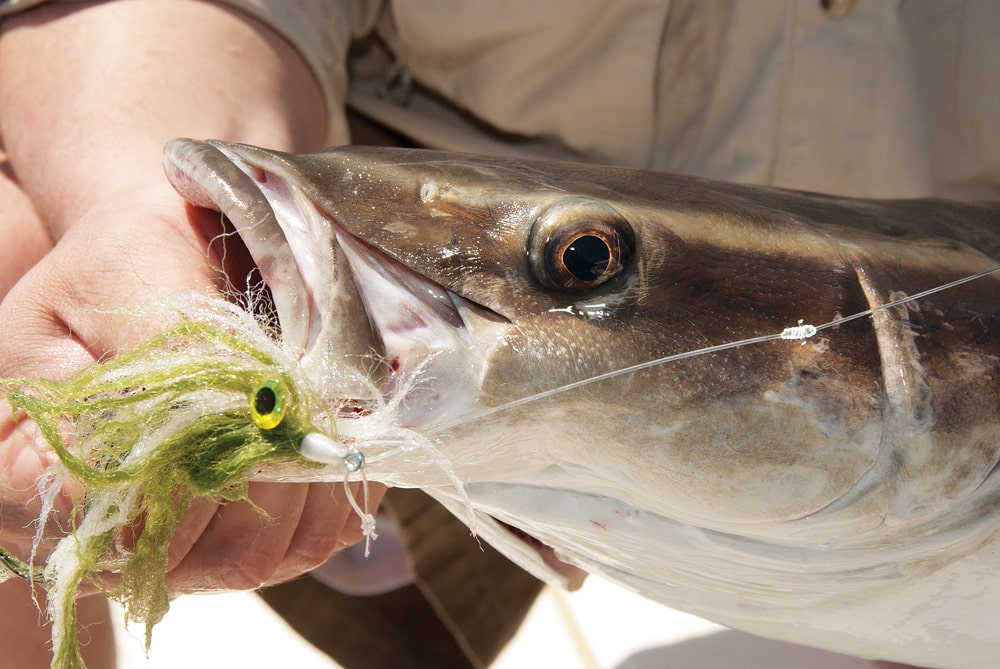
Results throughout the decades have shown that cobia definitely intermingle along different Gulf-state coastlines, though some areas have “subgroups” that won’t always migrate, including Florida Keys areas and deep waters of the northern Gulf, says Franks.
Three semidistinct migration groups in the Gulf of Mexico revealed themselves from tagging data. Following the warm water north in summer and south in winter, cobia almost always favor waters from the 60s to 80s, says Franks. Cobia spring migrations are water-temperature related and likely linked to pre-spawning behavior.
“Fish head from [west] Florida up the Panhandle to Mississippi in the summer, then back to South Florida in the winter,” says Hendon. “In the western Gulf, cobia hang around Texas and Mexico in the winter, but head north to Louisiana in the summer.”
On the Atlantic Coast, cobia migrate as far north as Chesapeake Bay in summer and back down to Florida waters in winter. An invisible dividing line between Gulf and Atlantic cobia groups seems to be southeastern Florida.
The Cobia Tournament Fishing Craze
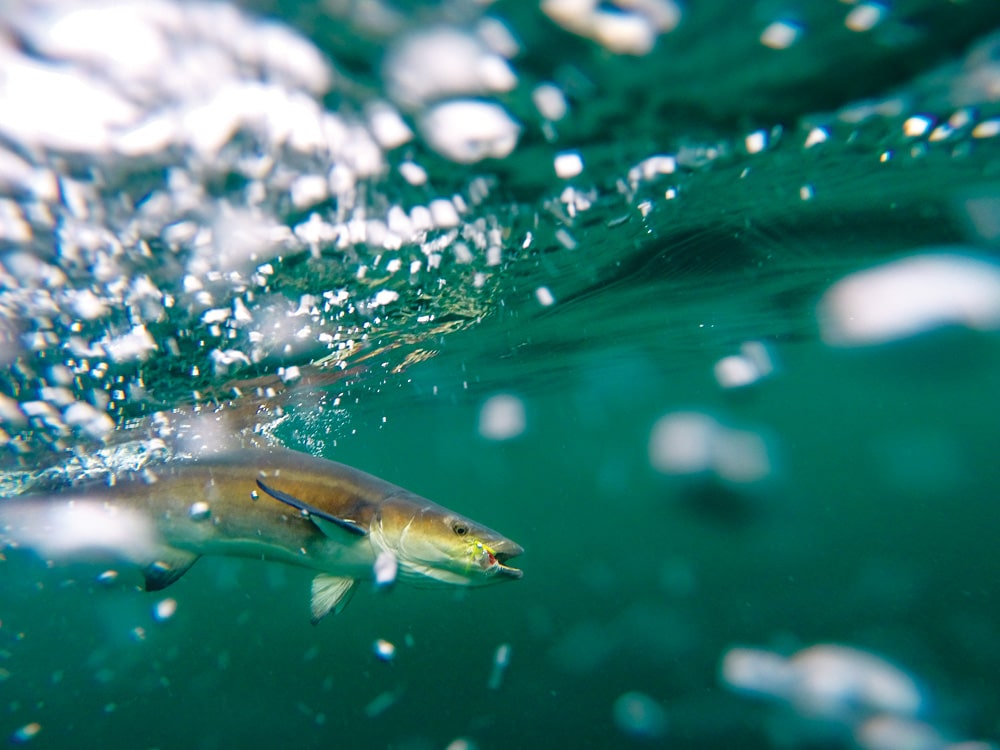
From Florida’s Panhandle to Mississippi each spring you’ll see the world’s most fanatical cobia fishermen, duking it out in tournaments along the beaches. The reliable sight fishery in this portion of the northern Gulf is highly publicized, yet it keeps producing year after year.
Cobia heading west migrate tightly along the beaches each spring, allowing anglers to spot singles and pods throughout the day from tower boats. Quizzically, the return trip for cobia in fall is much more of a shotgun migration, preventing fishermen from reliable catches on a day‑to-day basis.
Action available to anglers each March though June has led to a booming tournament craze. The Cobia World Championships, Hog’s Breath Cobia Shootout, HarborWalk Marina Destin Cobia Tournament and Gorenflo’s Cobia Tournament are just a few of the larger, better-known tournaments, though local cobia tournaments are available during many weekends in this region. Season-long cobia tournaments exist too, often with the first official cobia catch kicking off the event.
Capt. Pat Dineen, of Flyliner Charters in Destin, Florida, watches the chaos unfold every year. “The tournaments here are getting big, with payouts almost rivaling some of the blue marlin tournaments,” he says, only half-joking. Fish weighing 40 and 50 pounds are often the lowest weights entered, with bigger fish from 80 to 100 pounds claiming the prizes. Growing numbers of fishing crews tag and release smaller fish.
“Cobia really like [to eat] swimming pelagic crabs, though they’ll definitely eat finfish and eels,” says Franks. Dineen likes to have on his boat — a 24-foot Skeeter named Katie Anne — a variety of baits available, including cobia jigs and fly tackle. “Have as many flavors as possible, but show them only one flavor at a time,” he says. “A big, live mullet is always a good bait.”
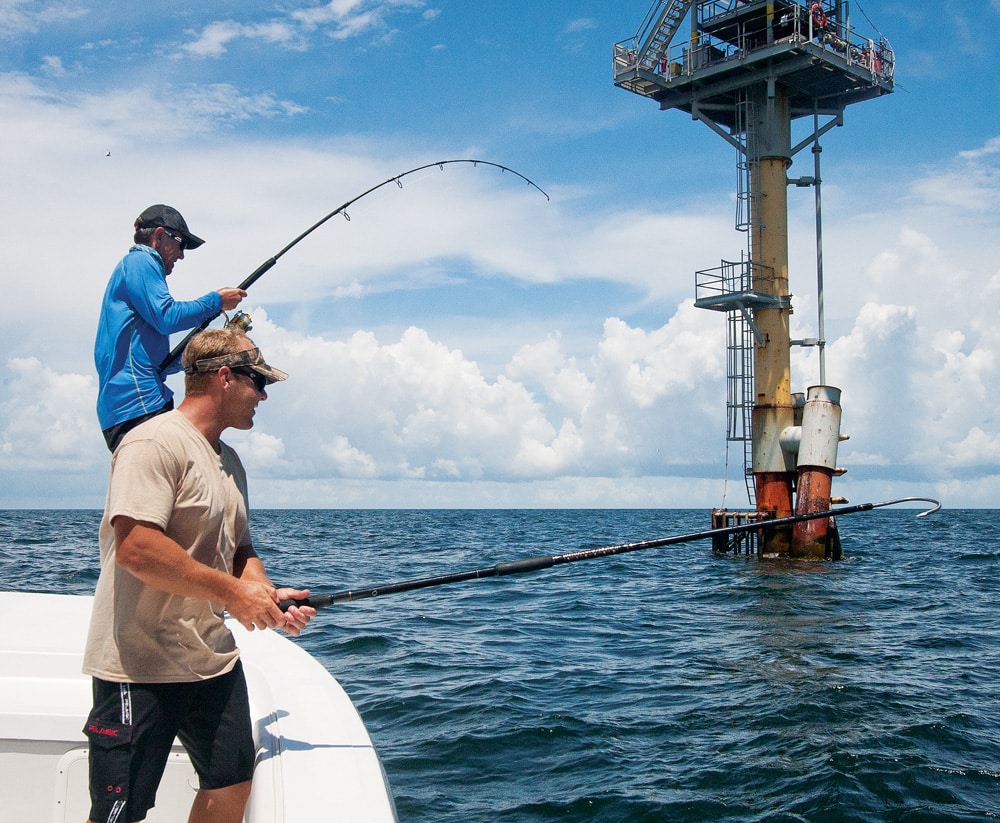
The days of spotting 30 fish in a day are mostly gone, but anglers can expect to see six to 15 fish daily, says Dineen. “It all depends on the year; last year we caught many of our fish late in the season. In March, the fish are moving hard to the west, but in April they seem more likely to bite.”
Some new trends have emerged in recent years. “Fishermen seem to be fishing deeper off Destin,” he says. “Before, they hunted cobia in 7 feet; now they’re fishing in 50 feet, which is still only ¾-mile offshore.”
Outlaw anglers deploy private fish-attracting devices (FADs) in slightly deeper waters, sometimes called “artificial turtles,” to attract cobia. That deploying private FADs is illegal doesn’t stop some from setting their homemade creations under the cover of darkness. A cobia’s affinity for sea turtles, rays, whale sharks and natural structure makes the taboo practice highly effective.
Lastly, when it’s time to bring that hooked cobia into the boat, a growing number of fishermen are opting for giant nets made from companies like Frabill instead of gaffs, says Dineen. The use of big nets in tournaments helps prevent any weight loss that might happen from a gaff hook. Nets also allow anglers to control cobia on the deck, as well as release any fish that won’t be eaten for dinner.
“More and more cobia are staying in the northern Gulf later in the season,” says Dineen. “Chumming for snapper off the beach in June, I often have cobia show in the chum line. Also in the fall, fishing for jacks around the structure, cobia will show then too.”
Cobia Farming and Aquaculture
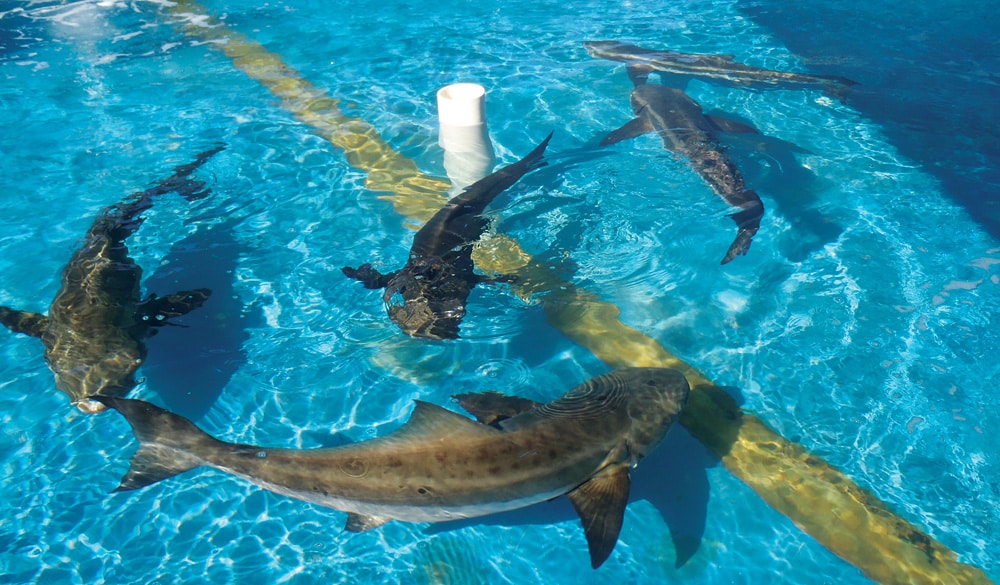
The hearty cobia’s incredible growth rate allowed researchers at the University of Miami to successfully spawn cobia and grow them via aquaculture methods. Daniel Benetti, a professor and director of aquaculture at the University of Miami, leads the efforts at the South Florida hatchery that eventually allowed the Open Blue company to farm-raise tasty cobia in giant pens off the Caribbean coast of Panama.
“In 2013, Open Blue produced a harvest weight of 1,000 tons of cobia,” says Brian O’Hanlon, founder of Open Blue. “In 2014, the number was closer to 1,300 tons.”
O’Hanlon has a family steeped in the seafood-selling industry, and O’Hanlon himself tried to spawn brood-stock red snapper caught from Alabama in his family’s New York basement when he was younger. Since then, he’s been a catalyst in the aquaculture industry, first testing mutton snapper and cobia in experimental anchored pens off the coast of Puerto Rico before settling on cobia in Panama.
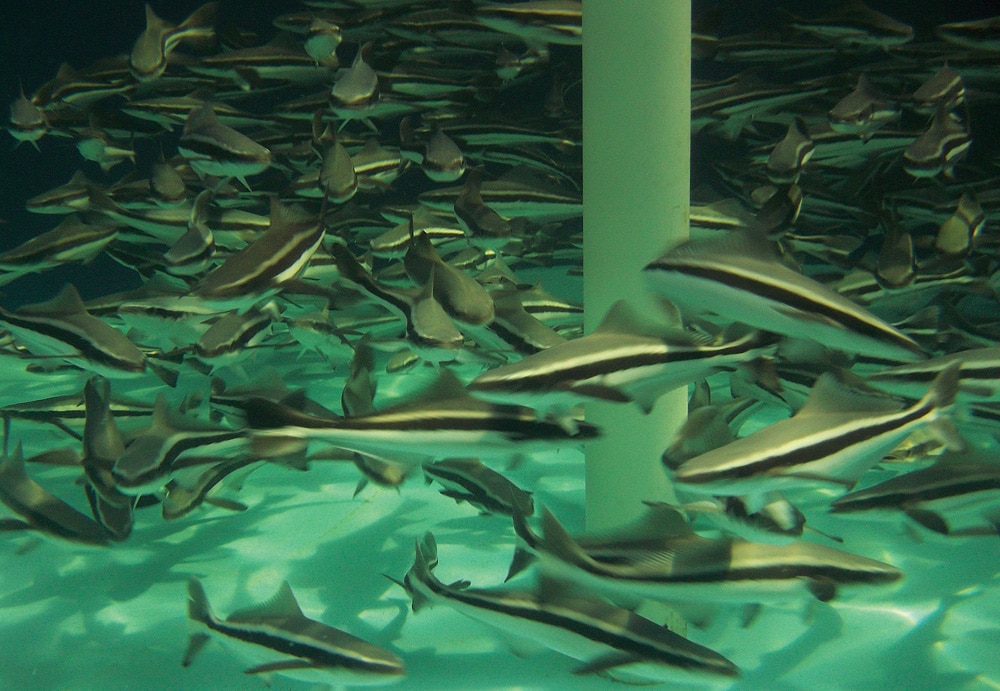
“We just finished our new hatchery in Panama, which includes a giant R&D center for nutritional studies to grow healthy fish,” he says. “One reason we chose Panama is because the United States is still in the bureaucratic process of creating laws that govern offshore aquaculture; there’s no structure yet for this new type of industry.”
About 20 pens, each holding 35,000 cobia, sit about 7 miles offshore in more than 200 feet of water. The pens are anchored in an area with no natural structure or sensitive habitat, but plenty of current keeps fresh, clean salt water flushing through the nets. The current also cleans out and dilutes cobia feces, so much so that University of Miami researchers have trouble identifying waste around the cages when testing for it.
“It’s not point-source pollution; it’s actually point-source creation,” says Benetti, “with the nutrients feeding the lowest members of the food chain.”
The fish are fed unique pellets made up of baitfish, soy, canola and other ingredients. This feed is much more efficient at growing cobia than traditional grub in the wild. “I would dare say that our cobia taste even better than wild-caught cobia because of the specific diet we feed them,” O’Hanlon says.
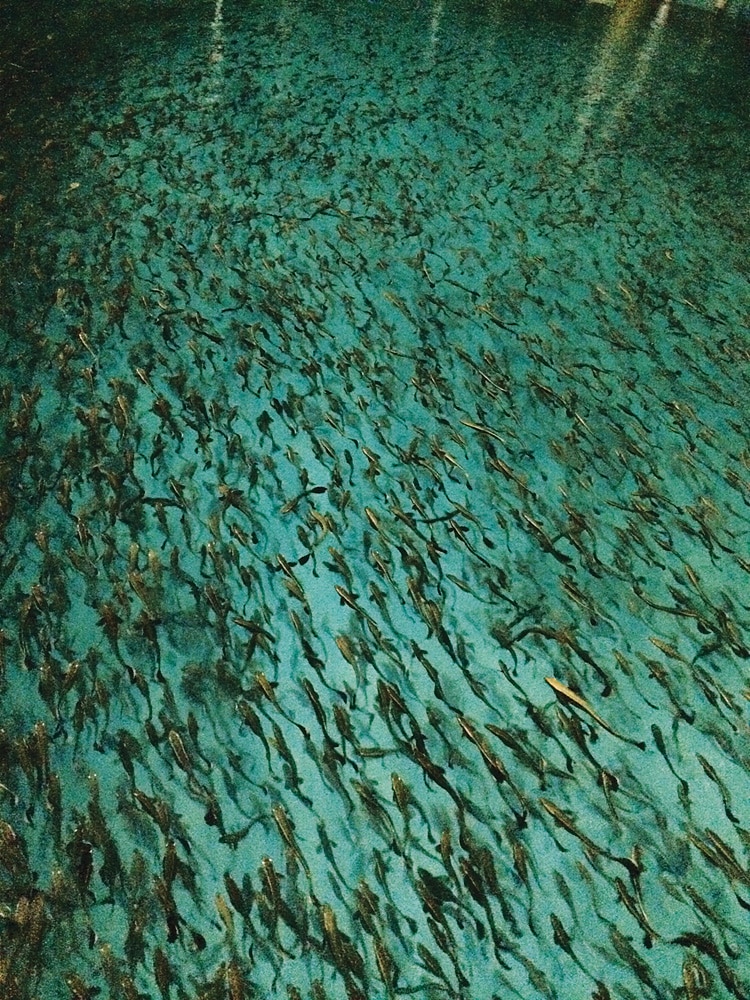
Cobia seems like a no-brainer as a saltwater aquaculture species, especially when it grows 10 times quicker than flounder, snapper and pompano. “From egg to 100 grams, cobia take about 100 days of growing in the hatchery,” says O’Hanlon. “After that, they’re strong enough to move offshore and handle the sometimes-turbulent conditions.” Cobia grow for nine to 10 months before being harvested, averaging about 12 pounds.
The United States imports up to 90 percent of its seafood, about half of which is from aquaculture, according to NOAA’s FishWatch. With the demand for seafood only growing, aquaculture operations like Open Blue’s for cobia should bolster existing wild stocks. Commercial harvest efforts could dramatically soften if tasty saltwater species are available via sustainable aquaculture.
Don’t be surprised if species such as tuna and snapper are the next on the list for offshore farming, says Benetti. And that’s good news for recreational anglers
Cobia Mysteries
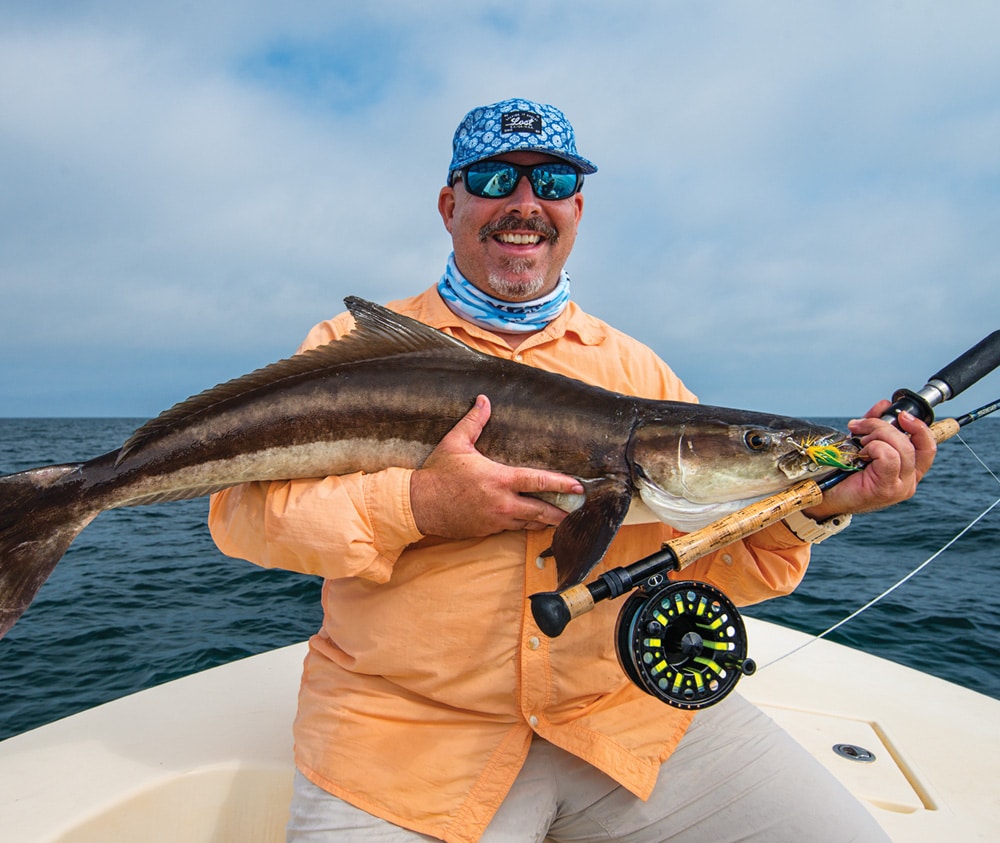
Two of the characteristics that most readily identify cobia are still largely unexplained, says Jim Franks.
When recreational anglers target cobia, the majority of fish are caught near structure, whether it’s a reef, oil rig, sandy drop-off near the beach, or even a live marine animal. When it’s the latter, sight-fishermen often see the shark, turtle, or ray before spotting the cruising cobia underneath. Luckily, cobia are often hungry, and will scavenge a properly placed bait or lure near the host.
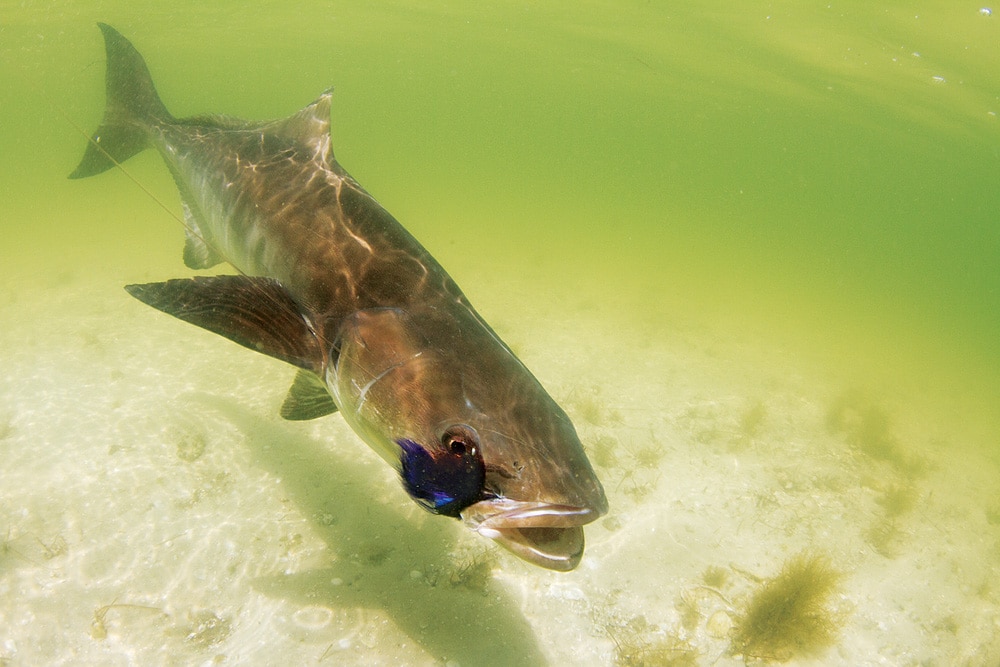
Cobia: Coastal Nomad
Their affinity for structure is an evolved behavior, says Franks. “Over the years, associating near other animals and structure must have provided some kind of evolutionary advantage,” says Franks. “It’s not that uncommon a behavior; other pelagics such as tuna and dolphin are attracted to structure.”
Besides their habits, cobia often come in two different shades: completely dark brown or horizontally banded in white and light brown. Both males and females in different sizes can exhibit the color schemes, says Franks.
The exact reasoning for different colorations isn’t entirely known, though it might have something to do with spawning behavior. During spawning, researchers have witnessed cobia undergo changes in body coloration from brown to a light horizontal-striped pattern, according to biologist Cathy Bester, of the University of Florida’s Museum of Natural History.



